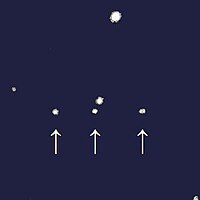Themisto (moon)
 |
|
| Discovery | |
|---|---|
| Discovered by |
Charles Kowal (1975) |
| Discovery date |
September 30, 1975 |
| Designations | |
| Adjectives | Themistoan, Themistonian |
| Orbital characteristics | |
| Periapsis | 5,909,000 km (0.039 AU) |
| Apoapsis | 8,874,300 km (0.059 AU) |
|
Mean orbit radius
|
7,391,650 km (0.04941 AU) |
| Eccentricity | 0.2006 |
| 129.82761 d (0.3554 a) | |
|
Average orbital speed
|
4.098 km/s |
| Inclination | 45.81° (to the ecliptic) 47.48° (to Jupiter's equator) |
| Satellite of | Jupiter |
| Physical characteristics | |
|
Mean radius
|
4 km |
| Circumference | ~25 km |
| ~200 km2 | |
| Volume | ~270 km3 |
| Mass | 6.89×1014 kg |
|
Mean density
|
2.6 g/cm3 (assumed) |
| Albedo | 0.04 (assumed) |
| Temperature | ~124 K |
Charles Kowal (1975)
Elizabeth Roemer (1975)
Scott S. Sheppard (2000)
David C. Jewitt (2000)
Yanga R. Fernández (2000)
September 30, 1975
Themisto (/θᵻˈmɪstoʊ/; from Greek: Θεμιστώ), also known as Jupiter XVIII, is a small prograde irregular satellite of Jupiter. It was discovered in 1975, subsequently lost, and rediscovered in 2000.
Themisto was first discovered by Charles T. Kowal and Elizabeth Roemer on September 30, 1975, reported on October 3, 1975, and designated S/1975 J 1. However, not enough observations were made to establish an orbit and it was subsequently lost. (See also lost minor planet.)
Themisto appeared as a footnote in astronomy textbooks into the 1980s. Then, in 2000, a seemingly new satellite was discovered by Scott S. Sheppard, David C. Jewitt, Yanga R. Fernández and Eugene A. Magnier, and was designated S/2000 J 1. It was soon confirmed that this was the same as the one observed in 1975. This observation was immediately correlated with an observation on August 6, 2000, by the team of Brett J. Gladman, John J. Kavelaars, Jean-Marc Petit, Hans Scholl, Matthew J. Holman, Brian G. Marsden, Philip D. Nicholson and Joseph A. Burns, which was reported to the Minor Planet Center but not published as an IAU Circular (IAUC).
...
Wikipedia
